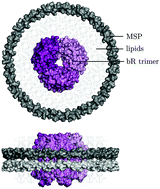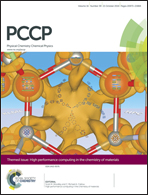The photocycle and ultrafast vibrational dynamics of bacteriorhodopsin in lipid nanodiscs
Abstract
The photocycle and vibrational dynamics of bacteriorhodopsin in a lipid nanodisc microenvironment have been studied by steady-state and time-resolved spectroscopies. Linear absorption and circular dichroism indicate that the nanodiscs do not perturb the structure of the retinal binding pocket, while transient absorption and flash photolysis measurements show that the photocycle which underlies proton pumping is unchanged from that in the native purple membranes. Vibrational dynamics during the initial photointermediate formation are subsequently studied by ultrafast broadband transient absorption spectroscopy, where the low scattering afforded by the lipid nanodisc microenvironment allows for unambiguous assignment of ground and excited state nuclear dynamics through Fourier filtering of frequency regions of interest and subsequent time domain analysis of the retrieved vibrational dynamics. Canonical ground state oscillations corresponding to high frequency ethylenic and C–C stretches, methyl rocks, and hydrogen out-of-plane wags are retrieved, while large amplitude, short dephasing time vibrations are recovered predominantly in the frequency region associated with out-of-plane dynamics and low frequency torsional modes implicated in isomerization.


 Please wait while we load your content...
Please wait while we load your content...